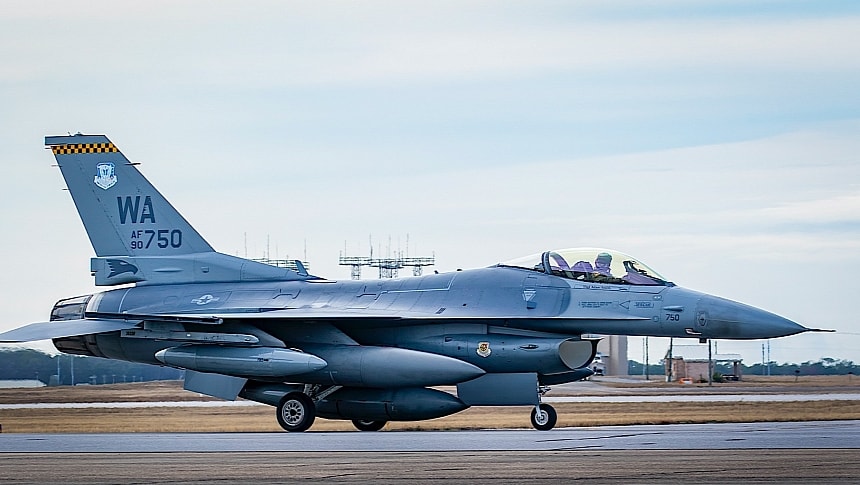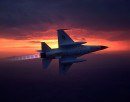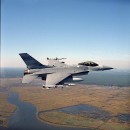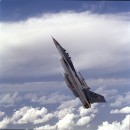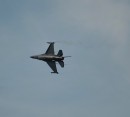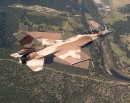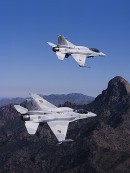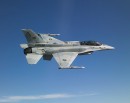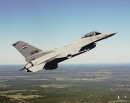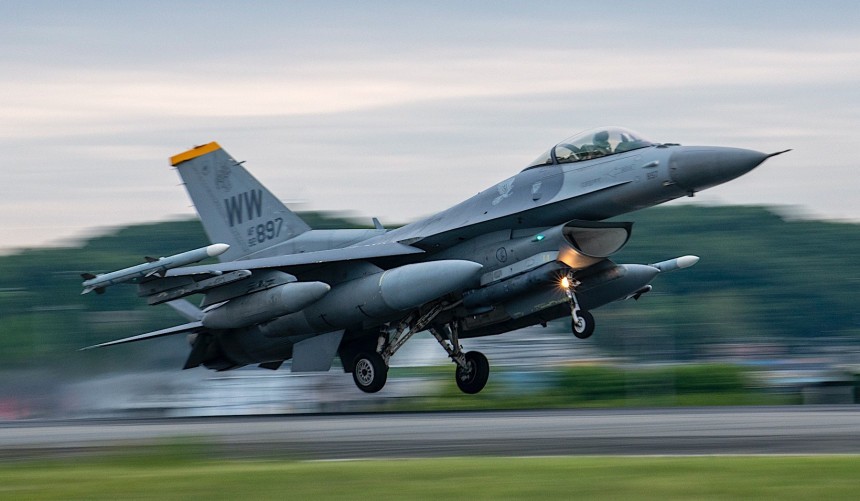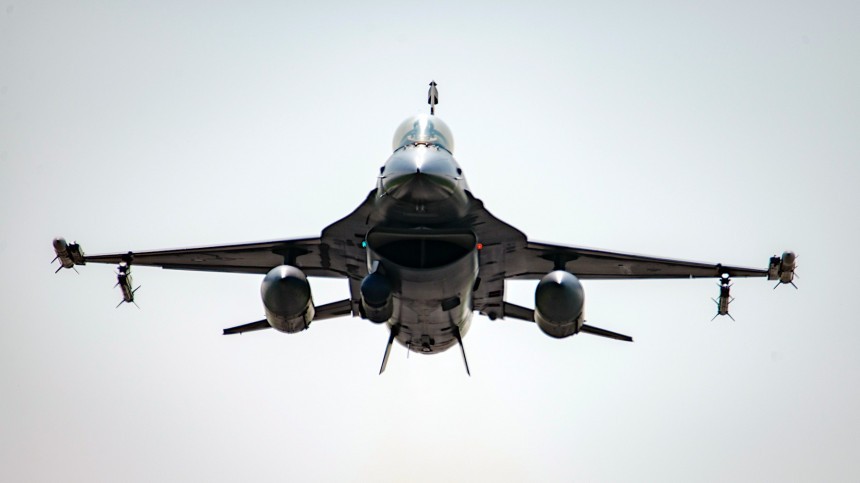There are several goals humans are presently pursuing with a lot more fervor than they do others. We have a push for the electrification of cars and motorcycles, but also an accelerated race to achieve the human expansion into the solar system. In the military world, the goal everyone seems to be pursuing is the autonomous nature of weapons and weapons platforms.
Having pieces of hardware go to war without putting humans at risk is something the militaries of the world have long dreamed about. That dream partly became a reality when drones arrived, and it will completely become so when military assets are completely autonomous.
For that to happen, though, a lot of research still needs to be done, and chances are this research will bring forth a lot of strange concepts. Like, say, autonomous F-16 Fighting Falcons that will never get to fly by themselves.
The Fighting Falcon, or the Viper, as many of the people working with these planes like to call them (some say in honor of the starfighters in the Battlestar Galactica TV series), needs little introduction.
The plane was born over at General Dynamics all the way back in 1976, and became operational three years later in the hands of the pilots of the 388th Tactical Fighter Wing. From that time and until now, the F-16 has become the most widespread fighter jet in the world, with over 4,600 of them made and deployed in no less than four main variants.
Now flying as a product of Lockheed Martin, the F-16 is one of the most potent multi-role fighters in the world. Powered by a single Pratt and Whitney or General Electric engine (F-16C/D version), the plane pushes through the air with the power of 27,000 pounds of thrust.
That's more than enough to allow it to reach top speeds of Mach 2 (1,534 mph/2,469 kph) and altitudes as high as 50,000 feet (15 km). The maximum range the Falcon is capable of achieving is 2,002 miles (3,200 km).
Being a multi-role fighter means the plane can carry weapons meant to strike both airborne and ground-based targets. Depending on its mission, it can be loaded with six air-to-air missiles, air-to-surface munitions, a 20mm multibarrel cannon with 500 rounds, and even electronic countermeasure pods.
Controlling an F-16 usually requires one or two pilots, depending on the version, for the simple reason it was never intended to fly autonomously. But that's exactly what the U.S. Air Force (USAF) has planned for it. Well, sort of.
America's power in the sky announced this week it is kicking off a research program called Viper Experimentation and Next-gen Operations Model - Autonomy Flying Testbed. VENOM-AFT for short, the program aims to "accelerate testing of autonomy software on crewed and uncrewed aircraft."
What that means is the USAF is trying to develop autonomous technologies that could be used on the battlefields of tomorrow. And since it's easier to test these technologies on existing platforms than actually build new aircraft for them, the F-16 has the honor of taking point in the program.
A number of three such aircraft were delivered this week to the Eglin Air Force Base in Florida to be modified into test platforms for autonomous tech. Naturally, we're not told exactly what the modifications will be, nor are we given any hint at what kind of autonomous tech we're talking about.
The USAF does reveal though that the groups tasked with testing the planes are the 40th Flight Test Squadron and the 85th Test and Evaluation Squadron (85th TES). The pilots of the two groups will be in the cockpit of the F-16s, monitoring the autonomous systems and making sure the objectives of the tests are completed. More importantly, though, the pilots will have the ability to turn autonomy algorithms on or off.
On top of that, the pilots will be tasked with providing feedback on the systems' performance to their developers so that improvements and tweaks can be made if need be.
A crucial aspect of the VENOM-AFT program is that the autonomous or partially autonomous F-16s will never fly without a human on board. At least that's what Lt. Col. Joe Gagnon, 85th TES commander, said when announcing the arrival of the three planes at Eglin.
The USAF does not say how long it will take until the implementation of the first autonomous system is complete. The military branch's higher-ups are hopeful the VENOM-AFT program will usher in a new era in aviation.
That's because whatever is learned from this will be used to inform another major program of the Air Force, the Collaborative Combat Aircraft that aims to spawn autonomous drones that support crewed aircraft on military missions. Unlike anything that came before them, these drones will be powered by AI, marking another crucial evolution of aerial warfare.
For that to happen, though, a lot of research still needs to be done, and chances are this research will bring forth a lot of strange concepts. Like, say, autonomous F-16 Fighting Falcons that will never get to fly by themselves.
The Fighting Falcon, or the Viper, as many of the people working with these planes like to call them (some say in honor of the starfighters in the Battlestar Galactica TV series), needs little introduction.
The plane was born over at General Dynamics all the way back in 1976, and became operational three years later in the hands of the pilots of the 388th Tactical Fighter Wing. From that time and until now, the F-16 has become the most widespread fighter jet in the world, with over 4,600 of them made and deployed in no less than four main variants.
Now flying as a product of Lockheed Martin, the F-16 is one of the most potent multi-role fighters in the world. Powered by a single Pratt and Whitney or General Electric engine (F-16C/D version), the plane pushes through the air with the power of 27,000 pounds of thrust.
That's more than enough to allow it to reach top speeds of Mach 2 (1,534 mph/2,469 kph) and altitudes as high as 50,000 feet (15 km). The maximum range the Falcon is capable of achieving is 2,002 miles (3,200 km).
Controlling an F-16 usually requires one or two pilots, depending on the version, for the simple reason it was never intended to fly autonomously. But that's exactly what the U.S. Air Force (USAF) has planned for it. Well, sort of.
America's power in the sky announced this week it is kicking off a research program called Viper Experimentation and Next-gen Operations Model - Autonomy Flying Testbed. VENOM-AFT for short, the program aims to "accelerate testing of autonomy software on crewed and uncrewed aircraft."
What that means is the USAF is trying to develop autonomous technologies that could be used on the battlefields of tomorrow. And since it's easier to test these technologies on existing platforms than actually build new aircraft for them, the F-16 has the honor of taking point in the program.
A number of three such aircraft were delivered this week to the Eglin Air Force Base in Florida to be modified into test platforms for autonomous tech. Naturally, we're not told exactly what the modifications will be, nor are we given any hint at what kind of autonomous tech we're talking about.
The USAF does reveal though that the groups tasked with testing the planes are the 40th Flight Test Squadron and the 85th Test and Evaluation Squadron (85th TES). The pilots of the two groups will be in the cockpit of the F-16s, monitoring the autonomous systems and making sure the objectives of the tests are completed. More importantly, though, the pilots will have the ability to turn autonomy algorithms on or off.
A crucial aspect of the VENOM-AFT program is that the autonomous or partially autonomous F-16s will never fly without a human on board. At least that's what Lt. Col. Joe Gagnon, 85th TES commander, said when announcing the arrival of the three planes at Eglin.
The USAF does not say how long it will take until the implementation of the first autonomous system is complete. The military branch's higher-ups are hopeful the VENOM-AFT program will usher in a new era in aviation.
That's because whatever is learned from this will be used to inform another major program of the Air Force, the Collaborative Combat Aircraft that aims to spawn autonomous drones that support crewed aircraft on military missions. Unlike anything that came before them, these drones will be powered by AI, marking another crucial evolution of aerial warfare.
